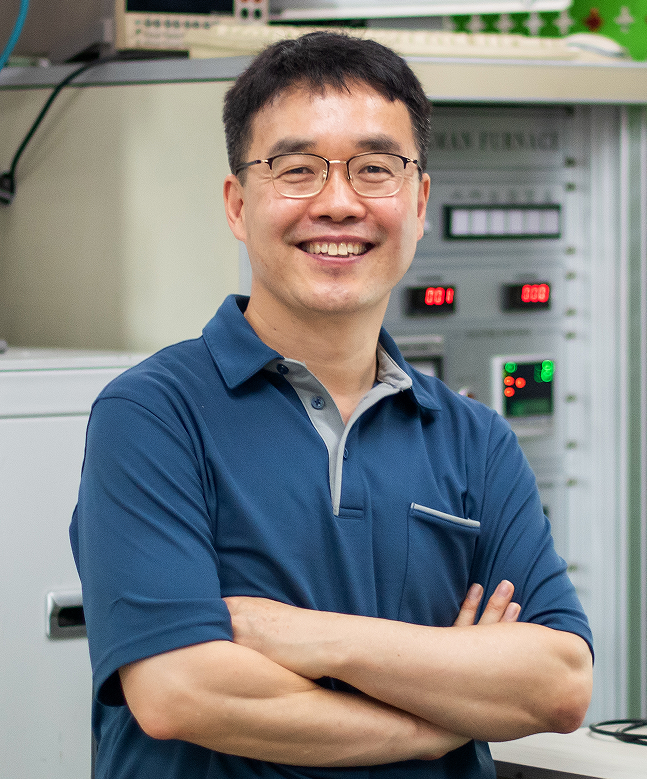Invited Speaker

Prof. Keeseong Park
Department of Physics and Chemistry,Daegu Geonbuk Institute of Science and Technology, Republic of Korea
Speech Title: From stoichiometric Mn₃Sn to hetero-kagome Zr₃Mn₃Sn₄Ga: emerging magnetism in kagome lattices
Abstract: The kagome lattice provides a versatile platform where geometrical frustration, magnetism, and topological band structures intertwine to yield exotic quantum phenomena. A prototypical example is the antiferromagnetic Weyl semimetal Mn₃Sn, whose triangular spin configuration generates a large anomalous Hall and Nernst effect, chiral anomaly, and magnetic spin Hall effect. Yet, the intrinsic properties of Mn₃Sn have often been obscured by non-stoichiometry. Using a Bi flux-assisted recrystallization method, we obtained stoichiometric single crystals with record residual resistivity ratios (RRR > 23) and sharp magnetic phase transitions [1]. These high-quality samples reveal well-defined helical ordering between 250–280 K and suppression of the anomalous Hall effect below the helical transition, establishing a reliable platform for studying the interplay of helical magnetism and topological bands.
Building on this insight, we extended kagome physics to a new frontier by realizing for the first time a hetero-kagome bilayer compound, Zr₃Mn₃Sn₄Ga, where non-magnetic breathing Zr₃Sn₄ and magnetic Mn₃Ga kagome lattices coexist in a single crystalline framework [2]. Bulk magnetometry and neutron diffraction confirm an antiferromagnetic transition at Tₙ ≈ 87 K with commensurate ordering, while transport studies show metallic behavior with large magnetoresistance and Hall slope changes across Tₙ. Resonant photoemission identifies Zr 4d and Mn 3d states as key contributors, demonstrating strong coupling between lattice, spin, and electronic degrees of freedom.
Together, Mn₃Sn and Zr₃Mn₃Sn₄Ga illustrate how kagome systems—through both chemical precision and structural heterogeneity—enable exploration of emergent magneto-topological phenomena and broaden the landscape of quantum kagome materials.
Keywords: Kagome lattice, magnetism, Mn₃Sn, Zr₃Mn₃Sn₄Ga
References:
1. J Park, WY Kim, B Cho, WJ Choi, YS Kwon, J Seo, K Park, Nominal kagome antiferromagnetic Mn3Sn: effects of excess Mn and its novel synthesis method, J. Mater. Chem. C, 2025,13, 11869-11878
2. J Park, B Cho, JS Oh, J Lee, T Rhee, D Lu, M Hashimoto, J Kim, K Park Zr3Mn3Sn4Ga: A new hetero-kagome bilayer antiferromagnet” Scripta Materialia 264, (2025) 116701
Biography: Prof. Keeseong Park is an Associate Professor in the Department of Physics and Chemistry at Daegu Geonbuk Institute of Science and Technology (DGIST), Korea. He earned his B.S. (1996) and M.S. (1998) in Physics from Seoul National University, served as an Instructor at the Korea Naval Academy, and completed his Ph.D. in Physics at the University of Texas at Austin in 2007. He later worked as a Research Associate at Brookhaven National Laboratory and Oak Ridge National Laboratory before joining DGIST in 2012.
At DGIST, he leads the Novel Quantum Materials Laboratory, focusing on the synthesis of single crystals, low-temperature physics, and x-ray and neutron scattering studies. His research explores superconductors, magnetic systems, and topological quantum materials. Recent publications highlight vortex dynamics in iron-based superconductors, kagome antiferromagnets such as Mn₃Sn and Fe₁₋ₓCoₓSn, and the discovery of Zr₃Mn₃Sn₄Ga as a hetero-kagome bilayer antiferromagnet.

